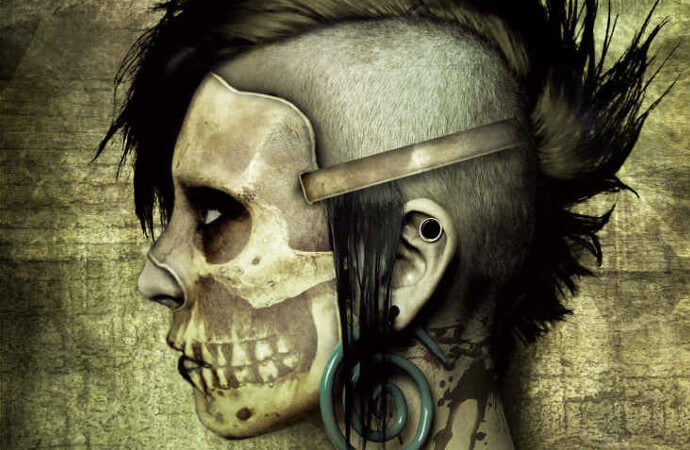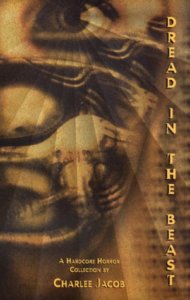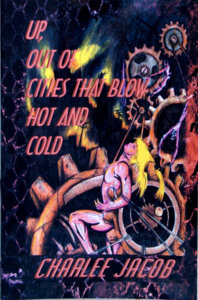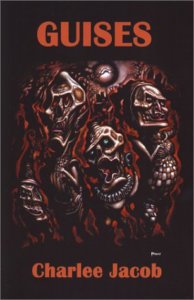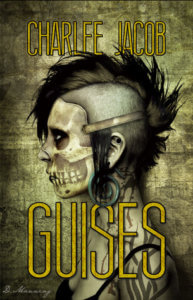“I want to be the woman in red,” says Grace to her tattooist.
It is the latest step in her journey of transformation. Grace has tried dressing in red, adorning herself with an array of sanguine garments: “Rustling scarlet taffeta. Crimson velvet as thick and soft as bat flesh. Wine colored underthings clinging like guilt.” She has even tried bathing in blood, buying rabbits at the farmer’s market to provide for her needs. Yet Grace remains unsatisfied. And so, she has her body covered with tattoos that depict sundry atrocities:
On her arms were witches being burned at the stake, a young voluptuous one on the right and a withered crone on the left, stretched on their stakes as the hooded faces of inquisitors leered. On her legs were auto accidents of red Corvettes with the drivers crawling mortally wounded from the twisted wreckage and the passengers hurled like cannon balls through the windshields to shred their souls in scarlet. Battlefields in a gamesman’s minute detail waged down the Gettysburg on her back. Her breasts were two red lamps in a basement where a fox-faced pervert had strung up rows of children with sad, milk-carton eyes. He was flaying them down to gleaming striated musculature.
The list goes on. On her posterior, Grace has an atomic explosion; on her cheeks, Aztec sacrifices; on the inside of one thigh, “the cartoon of a botched abortion.”
“There’s not a soul anywhere who would fail to agree that you are the woman in red,” says the tattoo artist to Grace. She walks out into the streets naked to show off her new adornments: “Secretly she smiled as a nun genuflected, a man actually vomited, and a mother jerked her small son away so he wouldn’t see, pressing his face to her lap like she’d stuff him back up into her before she’d let him view damnation walking by.” But Grace is still unsatisfied. She is not yet the woman in red.
The nude Grace is arrested, and her captors engage her in a curious philosophical discussion about the nature of atrocity. She then realises that these men are no ordinary police officers, and that the windowless building to which they take her is no typical police station. The desk sergeant, whose badge is decorated with strange runes, reveals that they serve someone who has been known by many names: Ereshkergal, Ixchel, Le-hev-hev, Hel, Thlen, Am-Mit, The Gorgons, Ilamatecuhtli, Kali Ghora-rupa. Grace is sent into a dark room, where she encounters a true woman in red:
She saw the blob propped up in the throne of carrion. The arms and legs had shrunken beside the giant body. Pendulous breasts hung to the hips, resting on the bloated body. If it had ever had proper arms and legs, it didn’t anymore as if it had eaten so much that it had been unable to walk for years. The body had grown enormous as the limbs had atrophied and shrivelled. What must have given it grasping ability were the tentacles that sprouted from the head. Like Medusa’s snaky hair. The dwarfing of the limbs until the body appeared to be nearly truncated reminded Grace of no less than every primitive clay goddess she’d ever seen.
There was a gap between the stumpy legs that flapped oiled palm leaves of vulva, flaccid with age. The face was a mass of wrinkles within wrinkles, folds that features had become lost in except for the eyes. That it had been eating was apparent in the remains of a (girl?) still clutched in tentacles, strings of which unravelled to vanish in the folds that surely hid the thing’s mouth in secret. This meal still rotated slowly as if trying to get free, mewling the unrecognizable noises of agony that might be a death chant in another language.
Speaking through telepathy, the being introduces itself. But the name it uses is not one of the mythological monikers cited by the desk sergeant. Instead, it identifies herself as Bathory — a name drawn from history rather than myth, evoking the semi-legendary murders of Countess Elizabeth Bathory. Under the influence of Bathory, the tattoos across Grace’s body become animated: the images turn into a living spectacle of death and destruction, blurring the line between art and atrocity, as the story’s protagonist begins the final stage of her transformation. She too, at long last, will attain the status of woman in red.
“The Woman in Red” — a story originally published in the 1995 SPGA Showcase anthology, and later reprinted in the 1999 collection Dread in the Beast — is characteristic of its author Charlee Jacob, who passed away earlier this year. It revels in death and disfigurement, and tries to squeeze as many acts of degradation and violation into its limited wordcount as possible. But in contrast to much extreme horror, it also strives to find creative, even poetic means of presenting its soul-shattering subject matter. Like the tattoos that adorn Grace’s body, it derives beauty from the irredeemable.
Furthermore, for all its visceral qualities, the story is willing to engage the mind as well as the gut, giving the reader something to contemplate as they wade through the carnage. During the climax of the story, Bathory explains to Grace the difference between goddesses of nature, and goddesses of humanity: “One creates; the other discreates. THEY’RE barefoot and pregnant forever. WE have FUN.” Citing quantum theory rather than mythology, Bathory reveals that the women in red, the dark quanta, the goddesses of humanity, are the ones who “produce the scarlet river that is human history”.
Charlee Jacob spent her writing career drawing from precisely that scarlet river.
Strange Beginnings
Born in Wichita Falls in 1952, Charlee Jacob made her debut as a fiction author in 1990, when her short story “September Street” ran in the Dallas Observer. Written from the perspective of an elderly woman with dementia, the story details how the protagonist’s memories of youth fade away one by one, leaving only blurred impressions of those around her:
Each old face she passes seems familiar but she decides that all old folks look alike, examples of decomposing time, a precognition of death that haunts her joints with aches from eternity because what else goes that deep? Pushing her cart, her arthritic ankles in their patchy, drooping socks seem to be picking their way over eggshells as she stares at the same withered face going by. She points to this one and that one, saying, “I know you, you old slit. I’ve seen your blackness under my doors.”
They rush past as everything seems to these days.
In “September Street” Jacob uses the deteriorating mental state of the main character to explore themes of intangibility and uncertainty. The story depicts reality as little more than a loose assemblage of mundane images, serving to obscure something unsettling and unknowable beyond the surface.
This was a fitting start to the career of Charlee Jacob. Moving her fiction from the mainstream confines of the Dallas Observer to dedicated horror publications like Prisoners of the Night, Styigian Articles and The Vampire’s Crypt, Jacob was able to delve further into darkness and nightmare. Like Grace’s quest to become the woman in red, Jacob’s literary journey was a concerted effort to find – and capture – the horrific, the extreme, and the taboo-breaking.
Charlee Jacob’s first two short story collections: Dread in the Beast (1999) and Up, Out of Cities that Blow Hot and Cold (2000).
Searching for the Horrific Sublime
In the writing of Charlee Jacob, horror is not something to run away from. Rather, it is something to embrace, to absorb. Jacob’s stories associate the horrific with the sublime: those who come face-to-face with horror will rise — or descend — to another plane of existence, far beyond anything experienced in the mundane world.
Sometimes the horrific-sublime manifests as a religious ecstasy, Jacob’s stories featuring a pantheon of deathly divinities replete with acolytes and penitents. “The Family of Death” (1996) describes a cadaverous urban goddess emerging from the city smog on Halloween and calling together her followers — people who are not members of any particular religion, “merely the faithful of the dead”. She bestows tricks and treats upon them until the last, a woman in a silken dress, is allowed to swap bodies with the goddess. The queen is rejuvenated, a crone who has become a maiden, and chooses a king from among those gathered. “Her full, pumpkin-hard breasts flattened against the tomb marble of his chest, her hips grinding against the grotesque nightmare of his loins”.
“The Santa Ana Winds” (1996) is another portrait of a death-goddess, one still more provocative. Here, a Mexican mother takes her lifeless baby to a church — the Cathedral of Stains, Gory Jerusalem — in hope of a miraculous resurrection. Inside are stained-glass depictions of bleeding martyrs and risen corpses, along with the statue of La Maria Sangrienta — the Bloody Mary — that is said to weep tears of blood. The mother does not find her miracle; she is instead forced to go on another pilgrimage — this time to a desert, the Burning Bethlehem — before her wish is fulfilled, and this macabre Madonna begets her messiah.
When it comes to achieving the horrific sublime, Jacob presents drugs as a viable alternative to religion — or, perhaps, as an adjunct to religion. “Mortal Wound” (1994) is the story of Joe and Jule, two acid-dropping who cruise the streets of Dallas looking for thrills (“Any old assault or rape at all will do as long as it’s visual”). Arriving at a freak show, they see a performance from a naked man with a large wound that — somehow — moves around his body, starting on his shoulder but migrating across his spine and down to his nether regions. The host explains that the man is too drugged to feel the migrating injuries, and Jule concurs: “I’ve seen that look on my own face in the mirror when I drop really good acid… It’s the crack drug of death itself, soothing and beatific with anesthetic shadow, making a martyr out of every piss-panted, murdered geek.” During the hallucinatory conclusion, the man’s chest explodes and the mobile wound is transferred to Jules’ body as he is injected with a drug; returning to the theme of religion, Jule compares both the dead man and himself to Jesus.
The dominant form of the horrific sublime, however, is sexual: in Jacob’s stories, the depths of macabre depravity are often equated with the most profound erotic pleasure.
“Loving Death” (1994) is written from the perspective of a necrophile, who narrates his perversions in terms of florid poetry (“I slipped past her tallow labia and into her womb of aspic, discovering cool euthanasia in the moments of release”) and finds the ideal partner when his latest exhumation turns out to be a vampire. “The Vat” (1994) introduces us to Rebecca, sole survivor of an old family; her deceased relatives are kept in a large vat, the corpses so decomposed as to be largely liquid. In another invocation of Elizabeth Bathory’s legendary predilections, Rebecca immerses herself in this ancestral fluid, achieving a “necrotic nirvana” as she finds oneness with her family. She then takes this practice further when she finds a lover, Sieva, who joins her in the corpse-vat for an erotic ballet (“A disembodied eye drifted near and Rebecca plucked it from the soup, then rubbed it over the other woman’s labia as her legs scissored in the putrid gum”).
“Getting Into Character” (1997) is the story of Naomi, an actress who models herself upon a deceased performer named Madame Lenore Sange:
When Naomi left the house, her mother was still talking, reminiscing about that ghastly but beautiful performance. How the dead had appeared to swoon, floating to the floor rather than tumbling like bodies really did. How music had seemed to flow from Madame Sange’s mouth whenever she parted her lips, a lorelei’s song, the melody of a lamia and a lilith.
The story ends with Naomi embracing the preserved body of Madame Sange onstage, finding empowerment, inspiration and arousal after kissing the lifeless form:
She ran her fingers across her breasts, the nipples erecting, carmine streaking her hands. She opened her mouth, the strains of an aria dolorosa flowing up from her lungs like a canticle wind.
Charlee Jacob’s third short story collection, Guises, in its 2002 and 2017 editions.
Dark as Ever
Charlee Jacob’s almost alchemical ability to create works of beauty from the most degraded and reprehensible subject matter required a vital ingredient. The element in question is simple for a reader to identify, but notoriously hard for an author to capture: it is a sense of the dreamlike.
“Most of my stories originate in nightmares,” said Jacob in an interview about her writing. Her 2000 collection Up, Out of Cities that Blow Hot and Cold offers a particular insight into her creative process, as each story opens with a short introduction about its origins. “This story came after watching the scene of a terrible air disaster on the news”, runs Jacob’s introduction to her story “Delta” (1994). “That night I dreamed of the devastation: bodies, jumble of metal, and scavengers.” The result of this was a tale about an Appalachian family who steal from wrecks of aircraft that they have brought down using black magic. And so, a real-life disaster was filtered through Jacob’s dreams, before giving rise to horror tale that benefited from two seemingly contradictory qualities: the ring of truth and the feel of a nightmare.
In his introduction to the collection, Tom Piccirilli notes Charlee Jacob’s habit of ending letters with the words “Dark as ever.” When discussing horror fiction, “dark” is an adjective that is almost inevitably too broad to be useful. But in the case of Jacob’s writing, the description is apt.
Jacob was able to capture in her stories that childhood fear of the dark room — the unseen corners where, to an infantile imagination, anything could be lurking. But more than merely recreating, it, she was able to adapt it to accommodate the anxieties of adulthood. As adults, we know full well what is lurking all too close to us: the predators and sadists, the wars and genocides, the calculated atrocities and tragic accidents. These are the fears that will remain in our minds when we turn out the lights, and will inform our nightmares when we close our eyes.
Charlee Jacob understood this. She used her talent as a writer to put nightmares on the page, dark as ever. She went further than that, however. She was able to capture why nightmares tend to fascinate our waking minds as much as they repel us as we sleep; she could show us the scarlet river in the dark. As did so many of her protagonists, Charlee Jacob found the sublime in the horrific.
All of the stories discussed above come from relatively early in Charlee Jacob’s career, before the publication of her debut novel This Symbiotic Fascination in late 1997. The next article in this series will examine how Jacob adapted her themes and motifs to a novel-length format.

